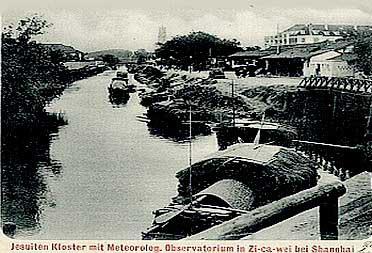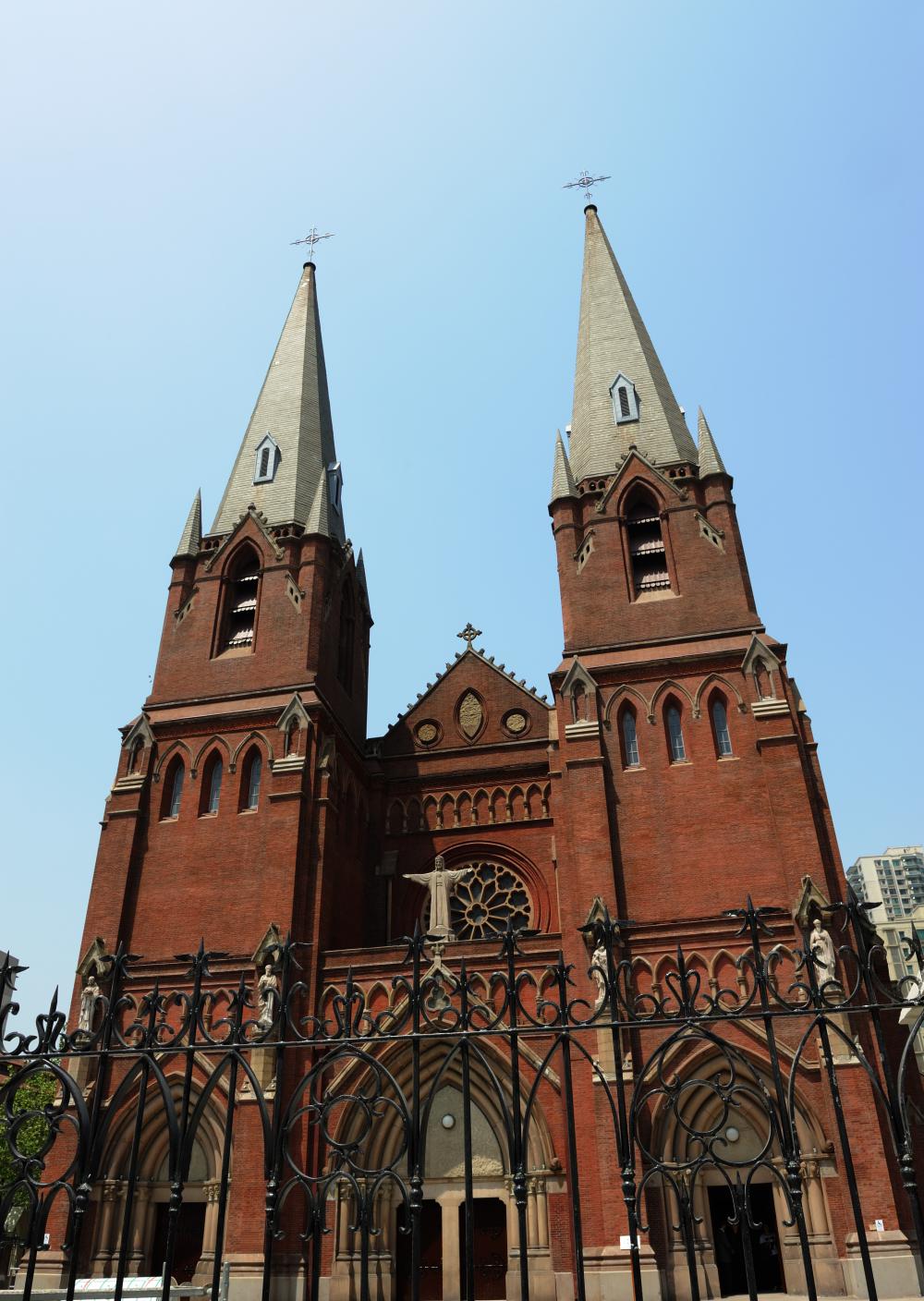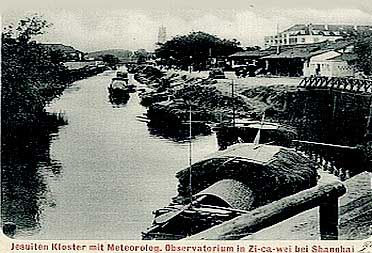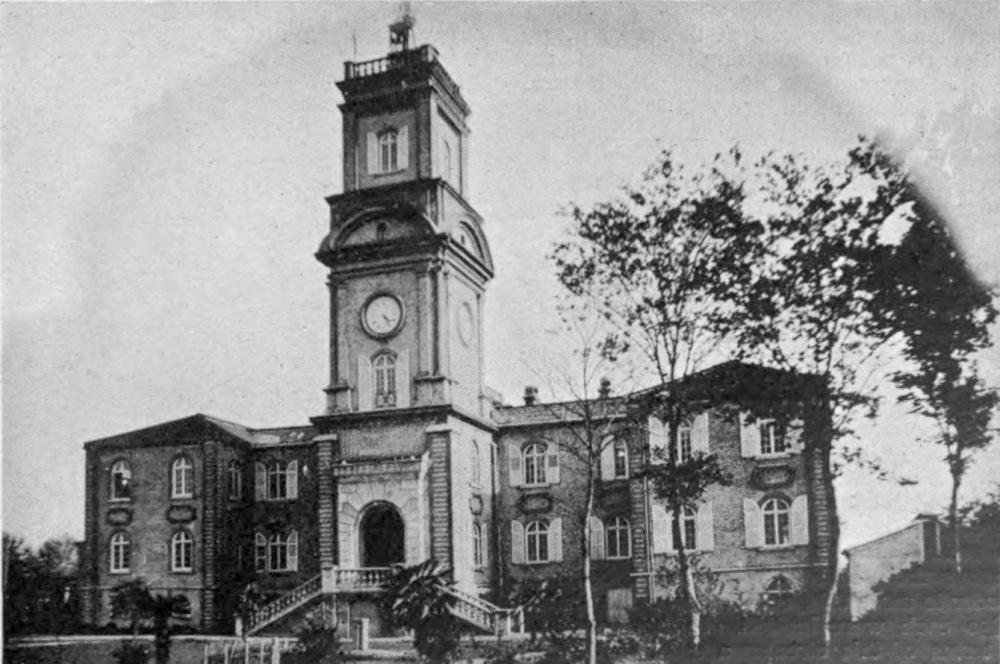
Category of Astronomical Heritage: tangible immovable
Shanghai Astronomical Observatory (Sheshan Station), China

Description
Geographical position
Shanghai Astronomical Observatory (Sheshan Station, Zô-Sé), Chinese Academy of Sciences, China
New Observatory: Shanghai Astronomical Observatory, 80 Nandan Road, Shanghai 200030, China
Location
Latitude 31°05’45’’ N, Longitude 121°11’04’’ E, Elevation 101m above mean sea level.
IAU observatory code
337
Description of (scientific/cultural/natural) heritage

Fig. 1. Jesuit Monastary and Meteorological Observatory Zi-Ka-Wei near Shanghai River, 1920s (Wikipedia)
Astronomy, timekeeping, solar observations, meteorology, terrestrial magnetism, and seismology played an important role in imperial expansion during the age of empire. After the suppression of the Society of Jesus (1773--1814) and the regeneration / restoration, Jesuit observatories were revived or newly erected in the 19th century, e.g. outposts of scientific excellence were established in the tropics, besides Zikawei Observatory Shanghai, China (est. 1872), e.g. Belén Observatory in Havana (Cuba), Manila Jesuit Observatory (Philippines, est. 1865), and Tananarive (now Antananarivo, Madagascar, est. 1889).

Fig. 2a. Meteorological Observatory ZiKaWei in Shanghai (Wikipedia, Arnold Wright)

Fig. 2b. Modern Meteorological Observatory Xujiahui-Guanxiangtai-Jiuzhi in Shanghai (Wikipedia, CC3, Fayhoo)
1. Zikawei (now spelled Xujiahui) Observatory, Shanghai (1872)
The observations started from a platform on the east side of the rectory of the present Saint Ignatius Cathedral on Sheshan Hill, used by French Jesuit from 1872 to 1900.
The Zikawei Observatory was founded by French Jesuits with four departments: Astronomy, Meteorology, Seismology, Magnetic Science -- Shanghai was the world’s largest meteorological station and one of the 70 Jesuit weather stations in China. The observatory is connected with a network of stations from Sibiria to Manila, from Indo-China to Guam in the Pacific.
The Astronomical, Magnetic and Meteorological Observatory was built next to (1873, next building 1884), a new building was erected one hundred metres west of the old observatory in Puxi-Str. 166, 1901).
Marc Dechevrens (1845--1923), educated in the Jesuit College Stonyhurst in Lancashire, was an important Director of Zikawei Observatory in Shanghai, 1876 to 1887, especially interested in measurements of the Earth’s magnetic field; the observatory is 30 miles from Shanghai in Loh-Ka-Pang. Also seismology was made in Zikawei, equipped with a Wiechert horizontal pendulum and a Galitzin vertical seismographic recorder.

Fig. 3. Time Ball in Zikawei Observatory in Shanghai (Schmitt 1932)
The observatory had very complete meteorological instrumentation, having a Secchi Meteorograph.
Magnetic instruments (for absolute measurements and variometers with photographic recording) acquired with Perry’s help were installed in a separate small octagonal building. This was the first magnetic station in China and the only one for many years.
The observatory had also a small telescope and a theodolite, used for time determination. The observatory war responsible for Weather and Time Service; radio broadcasting of time signals started in May 1914. Weather or storm signals were sent to the Semaphore for the ships. The time signal was indicated with a Time Ball at 11am, 12, 5pm, 8pm, in addition, at noon, a gun was fired.
From 1908, the observatory had a general director and three directors of the sections of meteorology, seismology and the time keeping service (Zikawei), astronomy (Zose) and magnetism (Lukiapang and Zose). In 1908, the geomagnetic section (director Josephus de Moidrey or Ma Delai, SJ), which had been established in 1877, was moved to Lukiapang, about 30 km from Zikawei, because the new electric tram interfered with the earth’s magnetic field measuring equipment as it passed by. It was connected by telegraph with Zikawei.

Fig. 4a. Sheshan Observatory in Shanghai (Wikipedia, CC4, Mountain)

Fig. 4b. Dome of the 1.56-m-Reflector of Sheshan Observatory (Tianwentai) in Shanghai (Wikipedia, CC3, Fayhoo)
2. Sheshan (Zose) Hill, 100m high (Observatoire de Zô-Sé), Shanghai Astronomical Observatory (1890), (code 337)
A branch observatory was erected on Sheshan Hill in Zose, 25 km southwest of Zikawei. Stanislas Chevalier was director of Zose for 28 years, the largest observatory in East Asia at the time. The research topics were sunspots, astrospectroscopy, gravity measurement and microquakes.
A 40-cm-Double Refractor, f=6.8m, Gauthier (1898/1900) was acquired, with equatorial mounting in a large dome of 10m diameter -- it was the largest optical telescope in East Asia at that time - used e.g. for observing of Halley’s Comet. From 1900 until 1930, thousands of photographic plates were made to study the sun spots, to compile an atlas of the moon with 15 plates, drawings of prominences, determination of the positions of more than 14,000 stars, and calculations of celestial mechanics.
Sheshan joined the international longitude determination activities (1926--1933) as one of the three world longitude reference points.

Fig. 4c. Sheshan Observatory in Shanghai (Chinadaily 2012)
3. Zose reopened as Shanghai Astronomical Observatory (SHAO), (Pinyin Shànghai Tianwéntái) of the Chinese Academy of Sciences (CAS) (1962)
In 1962, Sheshan Observatory was merged with Xujiahui Observatory and was renamed the Sheshan Workstation of Shanghai Observatory by the Chinese Academy of Sciences.
due to light pollution transferred to Anji, Zhejiang Province (2008).
The 65-m-Sheshan Radio Telescope (tianma) (2012) was the fourth largest in the world and the largest in Asia.
In 1960, the development of atomic clocks began, first with ammonia molecules, then caesium and finally hydrogen maser clocks.
In the 1970s, a considerable progress was made in Chinese astronomy. The scientific research staff of Shanghai Observatory designed a 156cm astronomical optical refracting telescope (1987 made).
In the SHAO museum, the 1.65m optical telescope can be found.
Sheshan Observatory is one of the top five astronomical research centers in China. In 1999, the head office moved to a new 19-storey building at Nandan Str. 80 in the Xuhui district in central Shanghai.
History

Fig. 5a. Meridian Circle of Sheshan Observatory in Shanghai (shanghaiscrap.com, Adam Minter)

Fig. 5b. Zeiss Blink Comparator of Sheshan Observatory in Shanghai (Wikipedia, CC3, Peter Potrowl)
Instruments
- Secchi Meteorograph
- Meteorological Instruments
- Magnetic Instruments
- Seismology: Wiechert horizontal pendulum and a Galitzin vertical seismographic recorder
- New Seismological Institute (1904): two horizontal Japanese Omori seismographs, improved in 1909 with a Wiechert horizontal seismograph of 1000 kg mass, in 1915 with a vertical Galitzin seismograph and in 1932 with a three component set of Galitzin-Wilip electromagnetic seismographs
- Small telescope
- Theodolite for time keeping
- Meridian Circle
- 40-cm-Double Refractor, f=6.8m, Gauthier (1898/1900), equatorial mounting, large dome of 10m diameter -- largest optical telescope in East Asia at that time (today )
- Blink comparator: "Blink comparator".
By swiftly comparing a series of photographs taken at different times, it is possible to detect the motion of some celestial bodies such as planets. Clyde Tombaugh discovered Pluto in 1930 with a similar instrument. - 1.56-m-Reflecting telescope
- Vacuum photographic zenith telescope (1970)
- Double-speed lunar camera (1970)
- 1.56-m-astrometric telescope (1987)
- three 30cm photoelectric telescopes (2003)
- 60-cm-Laser Ranging System for laser distance measurements to earth satellites and the moon
- 25-m-Sheshan Radiotelescope (SH25) near Shanghai
- 65-m-Tian Ma Radiotelescope (SH65) (2012)

Fig. 5c. 65-m-Sheshan Radio-Telescope of Sheshan Observatory in Shanghai (Ivan Soh Wei Ern)
Zikawei was one of the oldest observatories in China -- it was associated officially with the Maritime Department of Chinese Customs. From 1882, the observatory began sending all newspapers a daily bulletin with weather information and forecasts for the following day. In 1890, the observatory began making weather maps for the whole coast of China and started issuing meteorological warnings by telegraph.
In 1884, a connection of the observatory with the harbor by telegraph installed, as well as a mast, which, by means of visual signs, warned mariners of the weather conditions, especially during the typhoon season. The code, consisting of ten symbols, designed by Dechevrens, and later perfected by bis successors, was adopted by all of the maritime stations dependent on the administration of the Chinese Maritime Customs.
In 1884, a time keeping service was also established at the observatory for the setting the ship’s chronometers. The exact time at noon was marked by the dropping of a ball at a mast in the observatory, followed by a cannon shot at the harbour, and from 1909, it was also marked by a lurninous sign.

Fig. 6. Old Zikawei Observatory in Shanghai (photo: Gudrun Wolfschmidt)
Directors and Astronomers, Shanghai Astronomical Observatory, Zikawei (Xujiahui) and Sheshan Hill (Zose)
- Adrien Languillat (1808--1878), Apostolic Vicar of Zhili, founding of the observatory
- Augustin Colombel (1833--1905) - first director 1872
- Marc Dechevrens (1845--1923), director of Zikawei Observatory, 1876 to 1887 - then Director of Observatory of the Island of Jersey, 1893-1923 --
1879 great storm -- The study and forecast of typhoons became its main task. These severe storms periodically devastate the coasts of China from July to September.
In 1883 a meteorological station bad been established also in Hongkong, whose first Director was William Dorbeck. - Stanislas Chevalier (1852--1930) arrived in China in 1883 and succeeded Dechevrens in 1887--1898
cartographic study of the upper part of the Yangtze River. During his long river expedition he made more than 1200 astronornical observations.
In 1900 Chevalier took the initiative in establishing a true astronomical observatory to complement the work of Zikawei. This astronornical observatory was built on the Zose Hill (Sheshan).
He made a large number of observations of stars, sunspots and the orbits of asteroids and their perturbations which were published in 17 large volumes. - Louis Froc (1859--1932), Aloysius Fros or Lao Jixun, SJ, 1896 to 1932
From 1899 to 1902, a new and larger building was built at Zikawei for the observatory with three stories and a central tower of seven stories. In 1904 the section of seismology was inaugurated with the installation of two horizontal Japanese Omori seismographs, improved in 1909 with a Wiechert horizontal seismograph of 1000 kg mass, in 1915 with a vertical Galitzin seismograph and in 1932 with a three component set of Galitzin-Wilip electromagnetic seismographs.
1908 the geomagnetic section, which had been established in 1877, was moved to Lukiapang, about 30 km from Zikawei.
From 1908, the observatory had a general director and three directors of the sections of meteorology, seismology and the time keeping service (Zikawei), astronomy (Zose) and magnetism (Lukiapang and Zose).
The only Japanese Jesuit to work in an observatory was Paul Tsuchihashi (1866--1965), who was at Zose from 1906 to 1910 working on astronomy. He worked, especially, on the orbit of asteroids, and he was a professor of mathematics at the Jesuit Aurora University in Shanghai. - From 1924 to 1946 Edmund de la Villemarque (1881--1946) was at Zose and became astronomy section director from 1940. Louis Gauchet (1870-1951) and Maurice Burgaud (1884--1977) arrived in 1924. Gauchet collaborated with de la Villemarque on the study of the variation of latitude, stellar fields and the orbits of asteroids.
- Pierre Lejay (1898--1958), director 1931 to 1939, was appointed as General Director of the three observatories.
He greatly advanced the science of the observatories, especially in atmospheric physics and gravimetry. In 1932 as Director he installed new instruments to study solar radiation, such as Angstrom and Moll pyroheliometers and, in 1935, a heliospectrograph. He created a section of atmospheric physics, where some of the earliest studies of the ozone content in the atmosphere were made in 1935. In 1938 an ionospheric sounder was installed, opening a line research on the physics of the upper atmosphere.
The work of the observatory continued and in 1933 the weather service to maritime navigation was extended also to air navigation.
From 1939, after Lejay’s departure to France, the three observatories of Zikawei, Lukiapang and Zose functioned autonomously with three directors, namely, Gherzi, Burgaud and de la Villemarque. - Ernesto Gherzi (1886--1973), the last Director of the Meteorological and Seismological Observatory, Zi-ka-wei, Shanghai - 1955.

Fig. 7. Ernesto Gherzi (1886--1973), director of Zikawei Observatory in Shanghai (Schmitt 1932)
The Zose observatory, still using the old telescope, was reopened in 1962 with the name of Shanghai Astronomical Observatory dependent on the Chinese Academy of Science. After the Cultural Revolution, new instruments were installed in Zose in 1979 and astronomical observations resumed.
Directors and Astronomers, Shanghai Astronomical Observatory (SHAO), Zikawei (Xujiahu) and Sheshan (Zose) merged, Chinese Academy of Sciences, (1962)
(31°11’25"N 121°25’46"E)
- Li Heng (1962 to Cultural Revolution)
- Ye Shuhua (1978 to 1979)
- Li Heng (1979 to 1981)
- Ye Shuhua (1981 to 1993)
- Zhao Junliang (1993- to 2003)
- Liao Xinhao (2003 to 2005, as executive vice director)
- Hong Xiaoyu (2005 to 2017, as executive vice director until 2007)
- Shen Zhiqiang (2017 to present)
State of preservation
Shanghai Astronomical Observatory Sheshan is preserved.
Comparison with related/similar sites
Outposts of scientific excellence were established in the tropics like Zikawei Observatory Shanghai, China (est. 1872):
Belén Observatory in Havana (Cuba), Manila Jesuit Observatory (Philippines, est. 1865), and Tananarive (now Antananarivo, Madagascar, magnetic observatory, est. 1889).
Threats or potential threats
no threats
Present use
Shanghai Astronomical Observatory Sheshan is still used as astronomical institute. In addition, there is an Astronomical Museum.
Astronomical relevance today

Fig. 8. Shanghai Astronomical Observatory, new main building (1999), Nandan Str-80 (Wikipedia, Pyzhou)
The Shanghai Astronomical Observatory (SHAO, Pinyin Shànghai Tianwéntái) of the Chinese Academy of Sciences (CAS) is an important astronomical research center.
References
Bibliography (books and published articles)
- Camus, Yves: Jesuit’s Journeys in Chinese Studies. Macau Ricci Institute 2007.
- Ern, Ivan Soh Wei: Observing the Observatories. The Ancient and Modern Chinese Universe. Yale-NUS College (October 5, 2015)
- Minter, Adam: In Memoriam: The Shanghai Astronomical Observatory. Shanghaiscrap (24 January, 2008).
- Schmitt, Richard B.: Zikawei Observatory, Shanghai, China. In: Bulletin of the American Association Jesuit Scientists, Baltimore, Maryland: Loyola College, Vol. IX, (1932), No. 4, p. 175-178.
- Udías, Agustín: "Jesuits’ Contribution to Meteorology." In: Bulletin of the American Meteorological Society 77 (October 1996), no. 10, 2307--2315.
- Udías, Agustin: Searching the Heavens and the Earth: The History of Jesuit Observatories. Dordrecht: Kluwer Academic 2013.
- Udías, Agustin: Jesuits and the Natural Sciences in Modern Times, 1814--2014. In: Jesuits and the Natural Sciences in Modern Times, 1814--2014. Leiden: Brill (Brill’s Research Perspectives in Jesuit Studies) 2019, p. 1--104 (doi.org/10.1163/9789004394902_002).
Links to external sites
- Xujiahui (Wikipedia) (Xujiahui observatory, now the Shanghai Bureau of Meteorology)
- Sheshan Observatory, China Daily (17 May 2012)
- History -- Shanghai Astronomical Observatory, Chinese Academy of Sciences
- Shanghai Astronomical Observatory, Chinese Academy of Sciences, Historical Developments (2016).
- The 60cm Laser-Ranging Station, Shanghai Astronomical Observatory
- The Laboratory of Technologies for Optical Astronomy, Shanghai Astronomical Observatory
- Astrophysics Division, Shanghai Astronomical Observatory
- National Time Service Centre (NTSC) of the Chinese Academy of Sciences -- Development History
No multimedia content published
Currently there is no multimedia content published for this case study






























